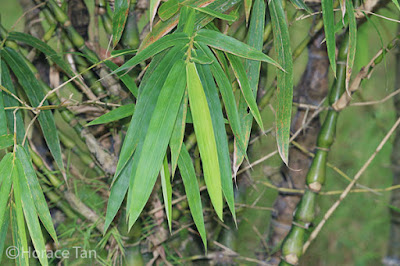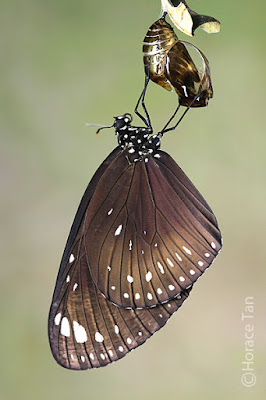Pre-Survey Training Sessions

The NParks Butterfly Count 2015 is a citizen science initiative, organised by NParks in collaboration with ButterflyCircle, to get Singaporeans involved in collecting valuable information about the butterflies in our parks and gardens.

Butterfly class in progress!
With the data collected from many survey transects from the various parks around Singapore, information on the distribution about butterflies can be pieced together to enhance park management and conservation measures. For example, if a park has a low butterfly count, more host and nectaring plants could be cultivated at the park to attract more butterflies.

NParks' Zhou Boyi sharing the key features to look out for when trying to ID butterflies
Members of the public, corporate, community and school groups are encouraged to sign up to participate in the island-wide butterfly count, focusing mainly on parks and gardens in Singapore. For participants who are new to butterfly identification, three sessions of basic butterfly identification and survey methodology were held in August to help these participants familiarise themselves with butterflies and how to ID them.

After the basic one-day training, participants will then be assigned to a designated park nearest to their homes to conduct the butterfly survey. The survey period will be over a week from 5 - 13 Sep 2015. The data collected will then be submitted to NParks for analysis which will result in management strategies to improve butterfly diversity in our parks.

Attentive students in class
ButterflyCircle members were involved in two of these training sessions for the NParks Butterfly Count 2015. Each training session had about 60+ participants with knowledge about butterflies ranging from total beginner to intermediate. The first session was held on 2 Aug at Singapore Botanic Gardens. The session started with a lecture about butterflies - some background information, morphology, interesting features, behaviour, early stages, other interesting data, etc. NParks' Zhou Boyi also presented a series of slides on butterfly identification and the features to look out for in the different species of butterflies.

The audience ranged from young kids to senior citizens. Everyone listened intently and a few were curious enough to ask many questions about butterflies. As it was a hot sunny day, everyone was raring to go out to show off their newfound skills in identifying butterflies. Each group, led by ButterflyCircle facilitators, took two transects to record their sightings of butterflies. ButterflyCircle veterans Federick Ho, Koh Cher Hern, Loke PF and Chng CK led their respective groups with NParks staff.

Everyone look up! There's a butterfly fluttering somewhere up in the trees!
It was fun as each group tried to record as many butterflies as they could. One comment from a participant was that, in the field, there was an added dimension of the characteristic of how different species have different flight patterns. Also, it was difficult to identify a fast flying butterfly or to be able to see the diagnostic features of the butterfly to ID it confidently.

Butterfly survey well under way
The second training session was held on 15 Aug 2015, also to another group of enthusiastic participants. Questions came fast and furious in the lecture room at Ridley Hall of the SBG. The younger participants were quick to pick up the differences between the lookalike butterflies, whilst the older members in the audience scrutinised their reference sheet carefully.

Mr Foo and the Seletar CC gang leading a group of 'students' on a survey transect
This session was facilitated by ButterflyCircle members Simon Sng and Huang CJ, but also in attendance was the founder of the Seletar Country Club's Butterfly Garden, Mr Foo Jit Leang and his enthusiastic bunch of knowledgeable lady members. The groups were assigned by NParks' Zhou Boyi, and off we went to our designated transects to start with the survey.

Basic rules of the Pollard Method of surveying butterflies. Image © NParks
Using the Pollard Method of survey, each group tried to document as many species of butterflies and the numbers of individuals spotted over each transect. Each short 200m transect took about 20 minutes to survey, and each group tackled two different transects at SBG to try their hand at surveying butterflies and recording the data in a simple format prepared by NParks.

NParks Zhou Boyi showing the group how to use the SGBioAtlas app
We hope that the short training session to identify about 20 common urban species would whet the appetites of the groups, enough for them to independently survey the parks in the vicinity of their homes. From 5-13 Sep, the official surveys will commence, and the participants who signed up for the survey can conduct their surveys on any of these days. Information to record include the weather, time of survey and the numbers and variety of species spotted.

SGBioAtlas app where field sightings of butterflies can be recorded by anyone! Image © NParks
Besides regular surveys conducted in the parks, NParks invites members of the public to submit photos of butterflies they have seen through the SGBioAtlas app (available on iTunes and Google Play Store) between 5 – 13 September to help us document the various butterfly species living around us. The SGBioAtlas app allows sightings to be geotagged and locations where the butterfly was encountered to be saved and subsequently submitted. It also has a comprehensive butterfly field guide to help users identify the species of butterfly spotted.

A happy group led by ButterflyCircle member Chng CK after their successful outing!
So to all the survey participants out there, go out and have fun and try your best to document all the butterflies that you spot in your nearby parks. A good day to be out there would be on Polling Day on 11 Sep. After casting your vote, head out to your nearby park and enjoy the extra public holiday whilst doing a bit of volunteer service to help NParks make our parks more butterfly-friendly for everyone to enjoy!
Text by Khew SK : Photos by Chng CK, Huang CJ, Khew SK, Loke PF, Simon Sng and Zhou Boyi.






































